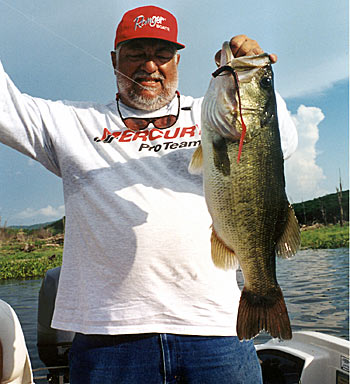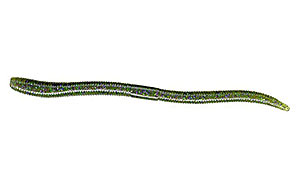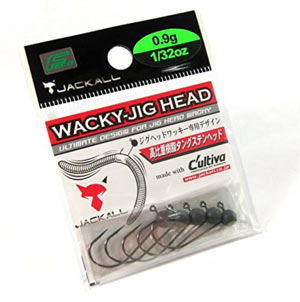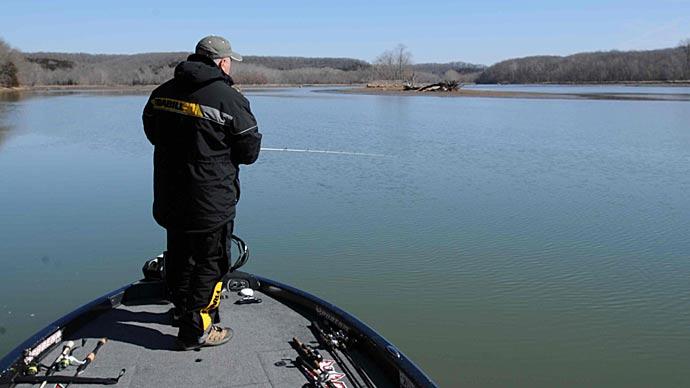
Bass are cold-blooded. When the water is cold, they slow down. This means they don’t have to eat as much, and it can make fishing for them a bit tougher. They stay deeper in winter and favor areas closer to the main lake. Long points and drop-offs near flats are good places to look for them. Keep an eye on your electronics and watch for the baitfish. Find the food, and you’re more likely to find the bass.
Finesse fishing is especially effective in winter because it offers an easy meal and mimics the cold-blooded bait fish: most of the time, a finesse bait is moved in place or given a prolonged fall rather than being moved quickly through the water or along the bottom. This gives the cold-blooded bass ample opportunity to make a decision and act on it.
Lately, the dropshot rig has been one of the most popular finesse methods, but it is by no means the only or even necessarily the best option available. When new methods come out, they are usually quickly adopted, and the old ways gets left behind, but if something is old enough, it can be as good as new when you pick it up again. Here are two older techniques that work very well, especially when everyone around you is drop-shotting.
Inchi Wacky or Flick Shaking
In Japan, heavily pressured bass water is a given. Since necessity truly is the mother of invention, Japanese bass anglers tend to come up with new finesse techniques on a pretty regular basis. Although the individual anglers would dearly love to keep their deadliest tactics secret, word leaks out, and before you know it, Americans have got their hands on the technique and are soon making alterations and trying new twists.

Called Inchi Wacky, Jig Head Wacky, or Flick Shaking, this method was introduced by Takuma Hata and Ty Ono. Ono and designer Seiji Kato started Jackall Lures in 1999, and they make special worms and jigs for the technique. The Inchi Wacky is a wacky-rigged soft plastic on a tiny jighead. But there’s a little more to it than that – the details make the technique deadly.
Nitro Pro Gary Senft loves to try new ways to catch bass. Gaining proficiency with various baits and methods is the mark of a good angler, and Senft is one of the best. Two decades ago, he discovered Inchi Wacky fishing and worked on perfecting his prowess with the Flick-Shaking technique for almost a year. Today it is still one of his best-producing finesse methods. “Those special jigs are pricey,” says Senft, “so I just squeeze a tiny split-shot onto a worm hook, and it works just fine.” The Jackall jigs are made on 90-degree bend hooks, but you can buy Gamakatsu 90-degree bend hooks in bulk at Bass Pro or Cabelas. Once you’ve got them, all you need is a variety of weight split-shots from 1/32-ounce to 1/8-ounce. Make sure to get the kind without ears.

The big key to flick-shaking is more in the fall than working the lure on the bottom. The Inchi Wacky should be rigged as light as possible. Jackall’s Flick Shake worms have an S-curve built in, so when they are rigged wacky style on a slightly weighted 90-degree bend jig head, they act strangely. The fall is unpredictable, and the bass can’t seem to help themselves. They bite. Their Wacky-Head Jig Heads have 90-degree bend and tungsten weights, and when paired with their special curved worms, they are deadly. You can buy the Wacky-Head Jigs almost anywhere. You can find a package of jigs competitively priced on Tackle Warehouse.
Senft says the basic technique is throwing the rig out and letting it fall on a slack line. He catches a lot of fish on the fall, and once it hits bottom, he lets it stay there on a slightly slack line and shakes the rod tip. Gary has experimented with various jigs and plastics, and most of his combinations have been successful. Finesse worms, small Senkos, small swimbaits, and larger plastic worms all catch fish when you rig them on these Inchi Wacky jigs. “You can fish them from a foot to thirty feet deep,” Senft says. The shallower you are fishing, the lighter the weight should be. He uses 4-pound-test fluorocarbon line and an ultra-light spinning rod with a very fast tip.
The open hook makes hooksets easy -- a lot of the time, the fish hook themselves. But it also means that this technique is difficult to use in heavy brush or weeds. A hook or jighead with a weed guard can help, but for the most part, this is more of an open-water method. Keep it as light as possible, rig it wacky, and give it some slack. A patient angler can drop it through tiny openings in floating mats.
If you can see submerged trees and brush in clear water, drop the Inchi Wacky rig next to the cover and let it wiggle its way down. The fall is so slow that any bass lurking in the depths of the tree has plenty of time to see it and decide to take a little taste. Just try not to rip it away from the fish when you see it dart out. This technique can also be used on any vertical structure – pilings, dams, piers, etc.
You don’t always see the fish come after it, of course. The bite can be a slight tick or a tug, or you may see your line swim off. Senft says that the bigger fish tend to swim off with it. You must sweep set and reel because the fine-wire open hooks do all the work for you.
Doodling
I first learned about doodling from the Doodle King himself – Don Iovino. When Iovino’s structure fishing techniques hit the bass fishing world, it was a bit of a revolution. Back then, depthfinders were nowhere near as refined as now – many anglers were still using flashers or paper graphs. But Iovino truly mastered the method of structure fishing and taught the West how to use depthfinders. I fished with him at El Salto a few years back, and the man is still a bass guru.
Doodling is a fantastic way to target bass that are lethargic. What you need is simple –faceted glass beads (6mm, 8m, or 10mm depending on the size of your sinker), brass sinkers, light line, and fine wire #1 offset hooks. Iovino has designed special doodling rods – they are about six feet long, medium action, with a fast tip. Use the lightest weight you can – Iovino bases weight choice on how hard the wind blows, not how deep he is fishing. He also has special worms and even kits you can get at www.iovino.com.
I fished Lake Pleasant in Arizona before the new dam was built, and it was tough back then. I’ll never forget one winter day shortly after attending a demonstration by Iovino. I rigged up a doodle rod – my 5-1/2 foot Enders topwater rod, with the brass and glass, a fine-wire hook, and a hand-poured purple, blue, and pink worm that everybody called a Margie Worm. We located a great rocky point with a very steep drop-off and just dropped the worms down there till they hit bottom. Once the worm was down, I reeled in just enough to keep the line a bit taut – tough with that light line – and I started gently shaking it. I’m not lying – within half an hour, an audience watched us catch one bass after another. It was amazing and one of my best days on Pleasant.
To get the feel of the bite, you must keep the line tight. You can feel the glass and brass clicking together better than you can the bite, so set the hook when it quits feeling sharp. It helps to keep the rod a bit high. John Murray turned me on to fishing this rig uphill on points. It’s much easier to keep the line tight by reeling in than by letting it out, so Murray would sit up on the shallow side of the point, cast out till it hit bottom, then shake and drag it back. He describes the bite as it feeling like you caught a rubber band.
You can get Don’s Doodling Kit for $70 on his website, and you can also get DVDs and his book. You don’t hear much about doodling these days, but that doesn’t mean it doesn’t work. Give the Inchy Wacky and Doodling a try this winter. They’re even fun to say!
BassResource may receive a portion of revenues if you make a purchase using a link above.




